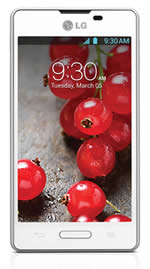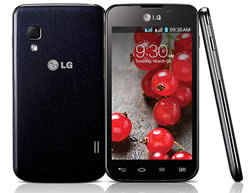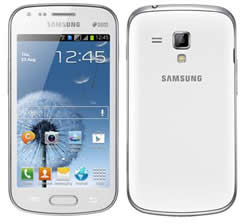Difference between LG Optimus L5 II, L5 II Dual and Samsung Galaxy S Duos
Key Difference: The LG Optimus L5 II and its counter part LG Optimus L5 II Dual are two entry-level smartphones by the company. The LG Optimus L5 II and L5 II Dual are quite similar to each other but differ in certain places, including looks. The device comes with a 4-inch True IPS LCD capacitive touch screen that offers around 233 ppi pixel density. Samsung Galaxy S Duos is a dual-SIM phone that was launched in September 2012. The phone comes with a 4-inch TFT capacitive touchscreen, with approximately 233 ppi density. The device comes with Samsung’s TouchWiz UI on Android 4.0.4 ICS.

LG has recently added a new phone series to its line-up. Following the original LG Optimus L series, the new phones include LG Optimus L3 II, LG Optimus L5 II and LG Optimus L7 II. The LG Optimus L5 II and its counter part LG Optimus L5 II Dual are two entry-level smartphones by the company. Although review websites say that the company has managed another miss, many users disagree and have enjoyed the phone specifically because of its cheap price.
The LG Optimus L5 II and L5 II Dual are quite similar to each other but differ in certain places, including looks. The Optimus L5 II has a bar format that has an oval hardware Home button on the front nestled right under the screen. This button is flanked by the Menu and Back capacitive buttons. The Optimus L5 II Dual, however, has four capacitive buttons Back, Home, Menu and the last button allows switching between the two SIM cards. The small design of both the phones is quite comfortable to hold and is also to use only with one hand. The buttons are also placed to make the device user friendly.
The power button is placed on the right side of the device, while the left side houses the volume rocker and a customizable button that is initially customized to Quick Note. The 3.5 mm jack is on the top of the device, while the USB charging port is on the bottom. The back of the device has the camera on the left side along with the LED flash on the bottom of it. The loudspeaker grille can be found on the bottom right corner. The company has given the back a ‘fake’ metallic look that can be passed of for a metallic back from far away. However, the back is made of plastic and has a little cheap feeling to it. The hardware Home button on the L5 II has LED behind it that illuminates while charging and also lights up different colors for different notifications.
 The device comes with a 4-inch True IPS LCD capacitive touch screen that offers around 233 ppi pixel density. The screen has decent resolution and clarity for the price. The phone is quite light and weighs around 103 grams for both models. Both the models come with Android 4.1.2 Jelly Bean out of the box and have been customized by Optimus 3.0 UI. The major difference between the two devices is the L5 II Dual’s ability to support dual SIM cards.
The device comes with a 4-inch True IPS LCD capacitive touch screen that offers around 233 ppi pixel density. The screen has decent resolution and clarity for the price. The phone is quite light and weighs around 103 grams for both models. Both the models come with Android 4.1.2 Jelly Bean out of the box and have been customized by Optimus 3.0 UI. The major difference between the two devices is the L5 II Dual’s ability to support dual SIM cards.
Both the devices are powered by 1 GHz single core processor, that results in lag if playing high-res demanding games. It also offers 512 MB RAM. The phones come with 4 GB internal storage capacity, of which only 1.75 GB is available to the user but, it can be expanded by 32 GB using a microSD card. The 1.75 GB still results in very less memory as Jelly Bean does not allow users to shift apps to the SD card. Both the devices come only with a 5 MP primary camera with a LED flash. The camera offers basic features such as geo-tagging, shot modes and a Cheese Shutter (that takes a photo when users say cheese). The camera also has VGA video taking capability.
The phone is powered by a removable Li-Ion 1700 mAh battery, which the company touts provides almost 10 hours of talktime on 3G network. The company has also provided with 50 GB of cloud storage and L5 II Dual offers a very cool feature known as On Screen Phone. This feature allows the phone to connect to a computer using USB or Wi-Fi, the user can then completely control the phone using the mouse and the keyboard. The application comes in the form of the phone on the screen and the user can also control the volume as well as the power buttons. The feature is a benefit for people that work on their computers continuously.

Samsung announced the Galaxy S Duos as an option aimed for people that require double SIM capability, eliminating the need for carrying two separate phones. The phone was launched in September 2012.
At first glance, the Samsung Galaxy S Duos bears heavy resemblance to the company’s flagship phone, the Samsung Galaxy S3. However, looking past the basic form of the phone and picking it up; the user can realize the reason for such a small price tag. The phone is a cheaper version of its big brother, with a lesser quality plastic and some downgraded features. However, let’s not label it as of yet, as it does come with some good specs. The 4-inch TFT capacitive touchscreen, with approximately 233 ppi density, is pretty decent with good contrast and colors but it is too reflective under sunlight, making it a bit difficult to use outdoors without squinting or trying to cover the screen.
The phone itself is easy to hold and handle, making it sleek and small enough to slip into jeans pockets or a small purse when on the go. The 120 grams of weight also ensures that the phone does put that much pressure on the hands when holding the device for longer periods of time. The top of the device houses only the 3.55 mm jack, while the bottom only has the USB/charging port. The right side of the device holds the power button on the top right hand and the microSD card slot. The left side of the device only holds the volume rocker, a bit hard to reach, if a person is used to having it on the right. On the front, the device has the home button that is surrounded by capacitive more options and a back button.
The device comes with Samsung’s TouchWiz UI on Android 4.0.4 ICS. Again, the UI is a toned down version of the one found on the S3. The device lacks the ripples effect and the water-drop sound and has four customizable shortcut buttons on the bottom of the lockscreen that can directly take you to apps such as missed phone calls when unlocking the device. The device allows users to add/remove apps from the homescreen as well as add/remove panels similar to other versions of Android.
The device is powered by a 1 GHz Cortex-A5, with about 786 MB of RAM. The RAM is a slight upgrade to the 512 MB available on other phones, but it still isn’t that great when trying to run dual-SIM, resulting in some lagging during operation. The dual-SIM capability and standby allows both SIMs to be operational at the same time. The device comes with a 5 MP rear camera for taking photos and recording videos. The rear camera is pretty decent in terms of taking photos. The images have pleasing colors and a good dynamic range, but the photos are a bit grainy. The phone also comes with features such as smile detection, geo-tagging, Share shot, effects and panorama mode. The S Duos also houses a VGA (0.3 MP) front camera that is as okay, nothing much to talk about. The phone can also capture videos in VGA resolution at 30fps.
The S Duos comes with a decent removable LI-Ion 1500 mAh battery, that according to the company provides a talk time of 770 minutes in 2G and 520 minutes in 3G, along with a standby time of 570 hours in 2G and 470 hours in 3G. The phone does not come with the same amount of features as available in Galaxy S3, but with the price tag of this device, it is still something. The main reason for purchasing the phone would still be the dual-SIM capability, while in other countries where dual-SIM options are more common, the phone may not fare as well.
The information for the detailed table about the two phones has been taken from the LG website, Samsung website and GSMArena.com.
|
|
LG Optimus L5 II/ L5 II Dual |
Samsung Galaxy S Duos |
|
Launch Date |
April 2013 |
September 2012 |
|
Company |
LG Electronics |
Samsung |
|
Size |
L5 II: 117.5 x 62.2 x 9.2 mm L5 II Dual: 118.4 x 62.2 x 9.2mm |
121.5 x 63.1 x 10.5 mm |
|
Display |
4-inch True IPS LCD capacitive touchscreen |
4.0-inch TFT capacitive touchscreen |
|
Screen |
480 x 800 pixels (~233 ppi pixel density) |
480 x 800 pixels (~233 ppi pixel density) 16M colors |
|
Protection |
- |
No |
|
Weight |
103 grams |
120 grams |
|
2G Network |
GSM 850 / 900 / 1800 / 1900 |
GSM 850 / 900 / 1800 / 1900 - SIM 1 & SIM 2 |
|
3G Network |
HSDPA 850 / 900 / 1900 / 2100 |
HSDPA 900 / 2100 - SIM 1 & SIM 2 |
|
4G Network |
N/A |
N/A |
|
GUI |
LG Optimus 3.0 UI |
TouchWiz 4.0 UI |
|
CPU speed |
1 GHz Processor |
1 GHz Cortex-A5 |
|
GPU |
PowerVR SGX531 |
Adreno 200 |
|
OS |
Android v4.1.2 (Jelly Bean) |
Android OS v4.0 (Ice Cream Sandwich) |
|
Chipset |
MTK 6575 |
Qualcomm MSM7227A Snapdragon |
|
RAM |
512 MB |
768 MB |
|
SIM Size |
L5 II: miniSIM L5 II Dual: Dual SIM |
miniSIM (Dual-SIM handset) |
|
Internal Memory |
4GB Internal (1.75GB User Available) |
4 GB (1.8 GB available to the user) |
|
Expandable Memory |
Up to 32GB |
Up to 32 GB |
|
Sensors |
Proximity, Ambient Light, Accelerometer, Digital Compass |
Accelerometer, Geo-magnetic, Proximity Sensor |
|
Connectivity |
Wi-Fi, Browser, Bluetooth, PC Sync Application, USB, Modem Function, On Screen Phone, Video Streaming, USB tethering. |
GSM; EDGE/GPRS (850/900/1,800/1,900MHz); HSDPA 7.2; Wi-Fi 802.11b/g/n 2.4GHz; Wi-Fi Direct; Bluetooth |
|
Data |
GPRS, EDGE, WLAN, Bluetooth, USB, NFC (L5 II) |
GPRS, EDGE, WLAN, Bluetooth, USB. |
|
Speed |
HSDPA, 7.2 Mbps; HSUPA, 5.76 Mbps |
HSDPA, 7.2 Mbps; HSUPA, 5.76 Mbps |
|
WLAN |
Wi-Fi 802.11 b/g/n, Wi-Fi Direct, Wi-Fi hotspot |
Wi-Fi 802.11 b/g/n, Wi-Fi hotspot |
|
Bluetooth |
Bluetooth v3.0 with A2DP, HS |
Bluetooth v3.0 with A2DP |
|
USB |
microUSB v2.0 |
microUSB v2.0 |
|
Primary Camera |
5MP AF Camera |
5 MP CMOS rear camera |
|
Secondary Camera |
N/A |
VGA CMOS front camera |
|
Video |
VGA @30fps (640x480) |
VGA@30fps |
|
Camera Features |
|
|
|
Sound Enhancement |
- |
No |
|
Audio supported formats |
MP3/ WMA / AAC / AAC+ / WAV / AC3 / AAC-LC, AMR-NB, WMA, WAV |
AAC, AAC+, AMR, AMR-NB, AMR-WB, eAAC+, I-Melody, IMY, M4A, MIDI, MP3, OGG, SP-Midi, WAV, WMA |
|
Video supported formats |
MP4/ H.264 / H.263 / WMV |
MPEG4, H.263, H.264 |
|
Battery Capacity |
Removable Li-Ion 1700 mAh battery |
Removable Li-Ion 1500 mAh battery |
|
Talktime |
3G: 9 hours 54 minutes |
2G: 770 minutes 3G: 520 minutes |
|
Standby Time |
3G: 642 hours |
2G: 570 hours 3G: 470 hours |
|
Available Colors |
Indigo Black, White, Pink, Titan |
White, Black, La Fleur |
|
Messaging |
SMS (threaded view), MMS, Email, Push Email, IM |
SMS (threaded view), MMS, Email, Push Email |
|
Browser |
HTML5 |
HTML, Adobe Flash Lite |
|
Radio |
FM radio with RDS |
Stereo FM radio with RDS |
|
GPS |
A-GPS |
GPS with A-GPS support |
|
Java |
Java MIDP emulator |
Java via Java MIDP emulator |
|
Additional Features |
|
|
Image Courtesy: lg.com, samsung.com









Add new comment